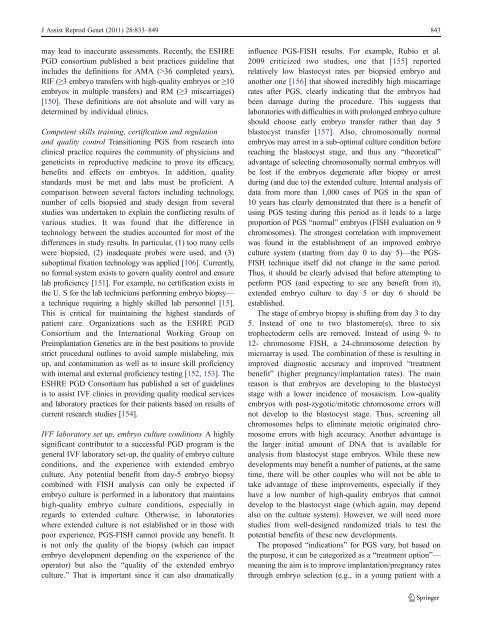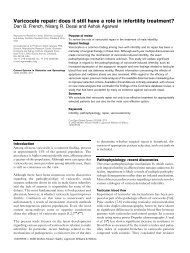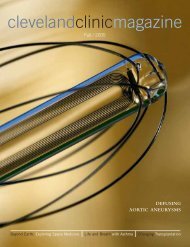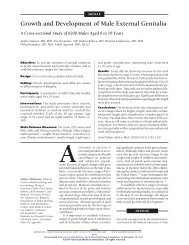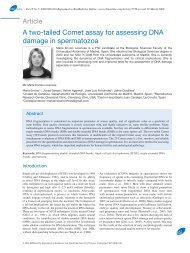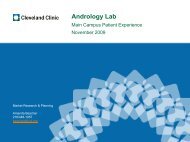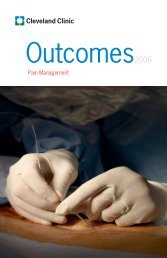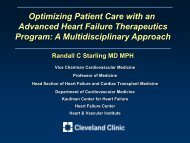Preimplantation genetic screening: does it help or ... - ResearchGate
Preimplantation genetic screening: does it help or ... - ResearchGate
Preimplantation genetic screening: does it help or ... - ResearchGate
Create successful ePaper yourself
Turn your PDF publications into a flip-book with our unique Google optimized e-Paper software.
J Assist Reprod Genet (2011) 28:833–849 843<br />
may lead to inaccurate assessments. Recently, the ESHRE<br />
PGD cons<strong>or</strong>tium published a best practices guideline that<br />
includes the defin<strong>it</strong>ions f<strong>or</strong> AMA (>36 completed years),<br />
RIF (≥3 embryo transfers w<strong>it</strong>h high-qual<strong>it</strong>y embryos <strong>or</strong> ≥10<br />
embryos in multiple transfers) and RM (≥3 miscarriages)<br />
[150]. These defin<strong>it</strong>ions are not absolute and will vary as<br />
determined by individual clinics.<br />
Competent skills training, certification and regulation<br />
and qual<strong>it</strong>y control Trans<strong>it</strong>ioning PGS from research into<br />
clinical practice requires the commun<strong>it</strong>y of physicians and<br />
<strong>genetic</strong>ists in reproductive medicine to prove <strong>it</strong>s efficacy,<br />
benef<strong>it</strong>s and effects on embryos. In add<strong>it</strong>ion, qual<strong>it</strong>y<br />
standards must be met and labs must be proficient. A<br />
comparison between several fact<strong>or</strong>s including technology,<br />
number of cells biopsied and study design from several<br />
studies was undertaken to explain the conflicting results of<br />
various studies. It was found that the difference in<br />
technology between the studies accounted f<strong>or</strong> most of the<br />
differences in study results. In particular, (1) too many cells<br />
were biopsied, (2) inadequate probes were used, and (3)<br />
suboptimal fixation technology was applied [106]. Currently,<br />
no f<strong>or</strong>mal system exists to govern qual<strong>it</strong>y control and ensure<br />
lab proficiency [151]. F<strong>or</strong> example, no certification exists in<br />
the U. S f<strong>or</strong> the lab technicians perf<strong>or</strong>ming embryo biopsy—<br />
a technique requiring a highly skilled lab personnel [15].<br />
This is cr<strong>it</strong>ical f<strong>or</strong> maintaining the highest standards of<br />
patient care. Organizations such as the ESHRE PGD<br />
Cons<strong>or</strong>tium and the International W<strong>or</strong>king Group on<br />
<strong>Preimplantation</strong> Genetics are in the best pos<strong>it</strong>ions to provide<br />
strict procedural outlines to avoid sample mislabeling, mix<br />
up, and contamination as well as to insure skill proficiency<br />
w<strong>it</strong>h internal and external proficiency testing [152, 153]. The<br />
ESHRE PGD Cons<strong>or</strong>tium has published a set of guidelines<br />
is to assist IVF clinics in providing qual<strong>it</strong>y medical services<br />
and lab<strong>or</strong>at<strong>or</strong>y practices f<strong>or</strong> their patients based on results of<br />
current research studies [154].<br />
IVF lab<strong>or</strong>at<strong>or</strong>y set up, embryo culture cond<strong>it</strong>ions A highly<br />
significant contribut<strong>or</strong> to a successful PGD program is the<br />
general IVF lab<strong>or</strong>at<strong>or</strong>y set-up, the qual<strong>it</strong>y of embryo culture<br />
cond<strong>it</strong>ions, and the experience w<strong>it</strong>h extended embryo<br />
culture. Any potential benef<strong>it</strong> from day-5 embryo biopsy<br />
combined w<strong>it</strong>h FISH analysis can only be expected if<br />
embryo culture is perf<strong>or</strong>med in a lab<strong>or</strong>at<strong>or</strong>y that maintains<br />
high-qual<strong>it</strong>y embryo culture cond<strong>it</strong>ions, especially in<br />
regards to extended culture. Otherwise, in lab<strong>or</strong>at<strong>or</strong>ies<br />
where extended culture is not established <strong>or</strong> in those w<strong>it</strong>h<br />
po<strong>or</strong> experience, PGS-FISH cannot provide any benef<strong>it</strong>. It<br />
is not only the qual<strong>it</strong>y of the biopsy (which can impact<br />
embryo development depending on the experience of the<br />
operat<strong>or</strong>) but also the “qual<strong>it</strong>y of the extended embryo<br />
culture.” That is imp<strong>or</strong>tant since <strong>it</strong> can also dramatically<br />
influence PGS-FISH results. F<strong>or</strong> example, Rubio et al.<br />
2009 cr<strong>it</strong>icized two studies, one that [155] rep<strong>or</strong>ted<br />
relatively low blastocyst rates per biopsied embryo and<br />
another one [156] that showed incredibly high miscarriage<br />
rates after PGS, clearly indicating that the embryos had<br />
been damage during the procedure. This suggests that<br />
lab<strong>or</strong>at<strong>or</strong>ies w<strong>it</strong>h difficulties in w<strong>it</strong>h prolonged embryo culture<br />
should choose early embryo transfer rather than day 5<br />
blastocyst transfer [157]. Also, chromosomally n<strong>or</strong>mal<br />
embryos may arrest in a sub-optimal culture cond<strong>it</strong>ion bef<strong>or</strong>e<br />
reaching the blastocyst stage, and thus any “the<strong>or</strong>etical”<br />
advantage of selecting chromosomally n<strong>or</strong>mal embryos will<br />
be lost if the embryos degenerate after biopsy <strong>or</strong> arrest<br />
during (and due to) the extended culture. Internal analysis of<br />
data from m<strong>or</strong>e than 1,000 cases of PGS in the span of<br />
10 years has clearly demonstrated that there is a benef<strong>it</strong> of<br />
using PGS testing during this period as <strong>it</strong> leads to a large<br />
prop<strong>or</strong>tion of PGS “n<strong>or</strong>mal” embryos (FISH evaluation on 9<br />
chromosomes). The strongest c<strong>or</strong>relation w<strong>it</strong>h improvement<br />
was found in the establishment of an improved embryo<br />
culture system (starting from day 0 to day 5)—the PGS-<br />
FISH technique <strong>it</strong>self did not change in the same period.<br />
Thus, <strong>it</strong> should be clearly advised that bef<strong>or</strong>e attempting to<br />
perf<strong>or</strong>m PGS (and expecting to see any benef<strong>it</strong> from <strong>it</strong>),<br />
extended embryo culture to day 5 <strong>or</strong> day 6 should be<br />
established.<br />
The stage of embryo biopsy is shifting from day 3 to day<br />
5. Instead of one to two blastomere(s), three to six<br />
trophectoderm cells are removed. Instead of using 9- to<br />
12- chromosome FISH, a 24-chromosome detection by<br />
microarray is used. The combination of these is resulting in<br />
improved diagnostic accuracy and improved “treatment<br />
benef<strong>it</strong>” (higher pregnancy/implantation rates). The main<br />
reason is that embryos are developing to the blastocyst<br />
stage w<strong>it</strong>h a lower incidence of mosaicism. Low-qual<strong>it</strong>y<br />
embryos w<strong>it</strong>h post-zygotic/m<strong>it</strong>otic chromosome err<strong>or</strong>s will<br />
not develop to the blastocyst stage. Thus, <strong>screening</strong> all<br />
chromosomes <strong>help</strong>s to eliminate meiotic <strong>or</strong>iginated chromosome<br />
err<strong>or</strong>s w<strong>it</strong>h high accuracy. Another advantage is<br />
the larger in<strong>it</strong>ial amount of DNA that is available f<strong>or</strong><br />
analysis from blastocyst stage embryos. While these new<br />
developments may benef<strong>it</strong> a number of patients, at the same<br />
time, there will be other couples who will not be able to<br />
take advantage of these improvements, especially if they<br />
have a low number of high-qual<strong>it</strong>y embryos that cannot<br />
develop to the blastocyst stage (which again, may depend<br />
also on the culture system). However, we will need m<strong>or</strong>e<br />
studies from well-designed randomized trials to test the<br />
potential benef<strong>it</strong>s of these new developments.<br />
The proposed “indications” f<strong>or</strong> PGS vary, but based on<br />
the purpose, <strong>it</strong> can be categ<strong>or</strong>ized as a “treatment option”—<br />
meaning the aim is to improve implantation/pregnancy rates<br />
through embryo selection (e.g., in a young patient w<strong>it</strong>h a


